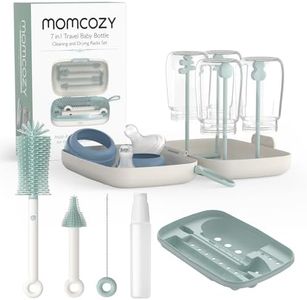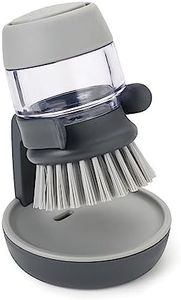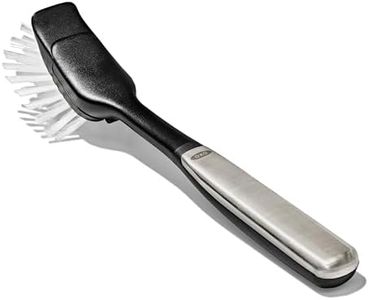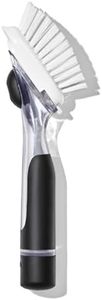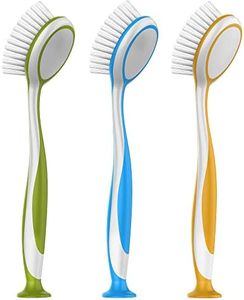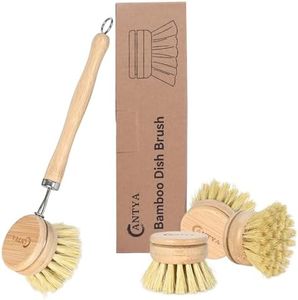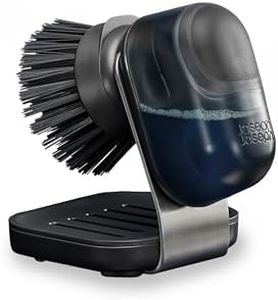We Use CookiesWe use cookies to enhance the security, performance,
functionality and for analytical and promotional activities. By continuing to browse this site you
are agreeing to our privacy policy
10 Best Dish Brushes
From leading brands and best sellers available on the web.Buying Guide for the Best Dish Brushes
Choosing the right dish brush can make dishwashing easier, more comfortable, and more effective. Instead of grabbing the first one you see, it's a good idea to think about how you'll use it, what types of dishes you have, and what features matter most for your cleaning routine. Dish brushes come in different shapes, bristle types, handles, and special features, so understanding these key aspects helps you pick one that matches your needs and preferences.Bristle MaterialThe bristles are the most important part of a dish brush since they do the cleaning. Bristles can be made of synthetic materials (like nylon, silicone), or natural fibers (plant-based or animal hair). Synthetic bristles are durable and dry quickly, which makes them good for general use and tougher scrubbing. Natural bristles are softer, biodegradable, and better for delicate surfaces or eco-conscious buyers. If you need to scrub stuck-on food, firmer synthetic bristles are useful. For gentle cleaning of sensitive items, a softer bristle is best. Think about the types of dishes you wash most often and select bristle material accordingly.
Handle Design and LengthThe handle affects comfort, reach, and control during use. Handles range from very short (palm brushes) to long (for deep pots or bottles). A short handle gives more scrubbing power but less reach, while a longer handle keeps your hands away from hot water and can reach into narrow containers or deep pans. Some handles are ergonomically shaped or have non-slip coatings for comfort and grip, especially if you wash a lot of dishes in one go. Choose a handle that aligns with your preferred washing style: short for control, long for reach, and ergonomic for everyday comfort.
Brush Head Shape and SizeHeads come in various shapes (round, oval, flat, angled) and sizes. A small, narrow head fits into bottles or cups, but may be time-consuming for large items. Larger or rounder heads clean plates and pans quickly but can struggle with tight spots. Some brush heads have angled designs to get into corners or around edges. Think about the main items you clean—select a shape and size that fits the largest and smallest dishes you typically wash.
Replaceable Head vs. Fixed BrushSome brushes allow you to replace just the head when worn out, while others are all one piece. Replaceable heads are better for sustainability and convenience; you keep the same handle and just swap the head. Fixed brushes are usually simple and often cheaper initially. If you value less waste or want a handle you already like, consider a brush with replaceable heads. Otherwise, an all-in-one brush might work fine.
Soap Dispensing FeatureSome dish brushes have a built-in soap dispenser, letting you squeeze soap directly onto dishes as you scrub. This can save time and make it easier to control the amount of soap used. However, these brushes can be bulkier or require more cleaning to prevent soap buildup. If you often need a lot of soap or value convenience, a dispensing brush may suit you. If you prefer simplicity, a standard brush may be better.
Cleaning and Drying EaseA brush that’s easy to rinse clean and dries quickly will last longer and stay more hygienic. Brushes with open designs or made from materials like silicone usually dry faster and harbor less bacteria. If you are concerned about cleanliness or want low-maintenance, look for brushes that are dishwasher safe or designed to dry quickly.
Eco-FriendlinessEco-friendly brushes use sustainable materials like bamboo handles and natural bristles, and may be compostable at the end of life. These are a good choice if you want to reduce plastic waste and your environmental footprint. However, eco-friendly brushes may require gentler cleaning and can wear out faster than synthetics. Decide how important sustainability is for you and balance it with durability needs.
